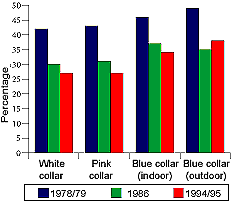
Smoking: an occupational hazard
CMAJ 1999;160:630
© 1999 Canadian Medical Association
Data from the 1994/95 National Population Health Survey indicate that workers' smoking patterns vary significantly by occupation and times worked. The Statistics Canada study revealed that although 28% of full-time workers smoke daily, workers are more likely to smoke if they work irregular hours or shifts involving weekends (29%), compared with workers who have regular weekday schedules (24%). More significant is that almost half (48%) of those who described their main activity as "looking for work" smoked daily, a figure that jumped higher (52%) for those who were ill or receiving disability payments.
| Prevalence of daily smoking by occupation* (Full- and part-time workers, aged 15 to 64) |
 |
| *Canada, excluding territories Sources: 1978/79 Canada Health Survey; 1986 Labour Force Survey; 1994/95 National Population Health Survey, supplementary file |
Among full-time workers, the prevalence of smoking every day was highest among male-dominated, outdoor, blue-collar occupations such as construction, transportation and mining, which had a combined rate of 43%. The rate was low for white-collar workers (18%) and even lower among those in scientific fields, in which only 16% of full-time workers smoked every day.
Almost 4 of 5 clerical workers (79%) encountered workplace smoking restrictions, compared with only 51% of those in sales and 40% of those in construction, transportation and mining. The quit rate (as measured by former smokers as a percentage of current smokers plus former smokers) was highest (60%) for workers in scientific, managerial or professional occupations, and lowest (40%) in construction, transportation, mining and similar occupations.
For the accompanying graph, white collar includes managerial/administration, sciences and other professional categories; pink collar comprises clerical, sales and service workers. Blue-collar indoor occupations include manufacturing and materials handling/crafts, and blue-collar outdoor includes forestry, farming, fishing, construction, transportation and mining.
This column was written by Lynda Buske, chief, physician resources information planning, CMA. Readers may send potential research topics to Patrick Sullivan (sullip@cma.ca; 613 731-8610 or 800 663-7336 x2126; fax 613 565-2382).
|
|
Send a letter to the editor Envoyez une lettre à la rédaction |
Autres chroniques Médicogramme |
